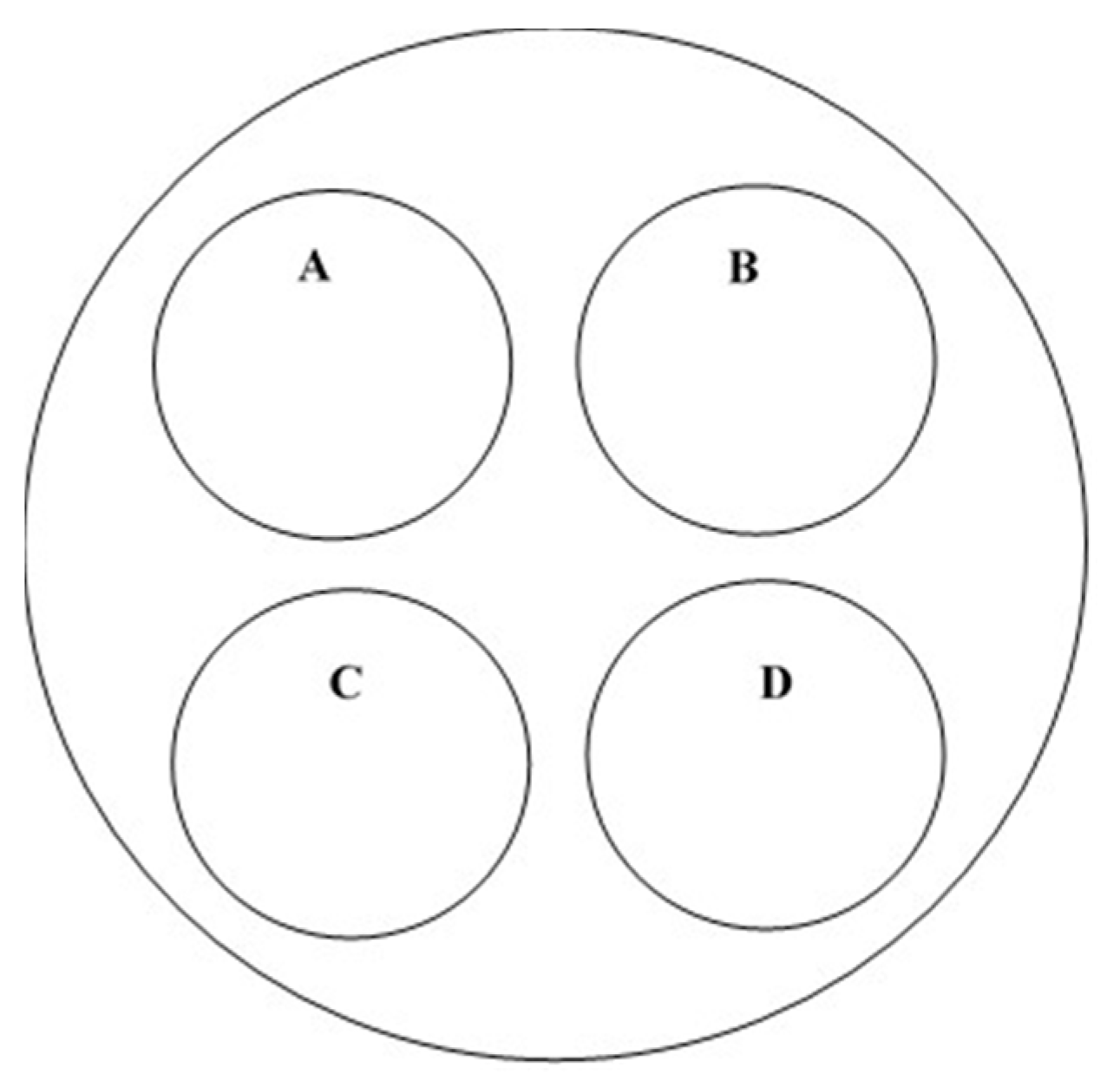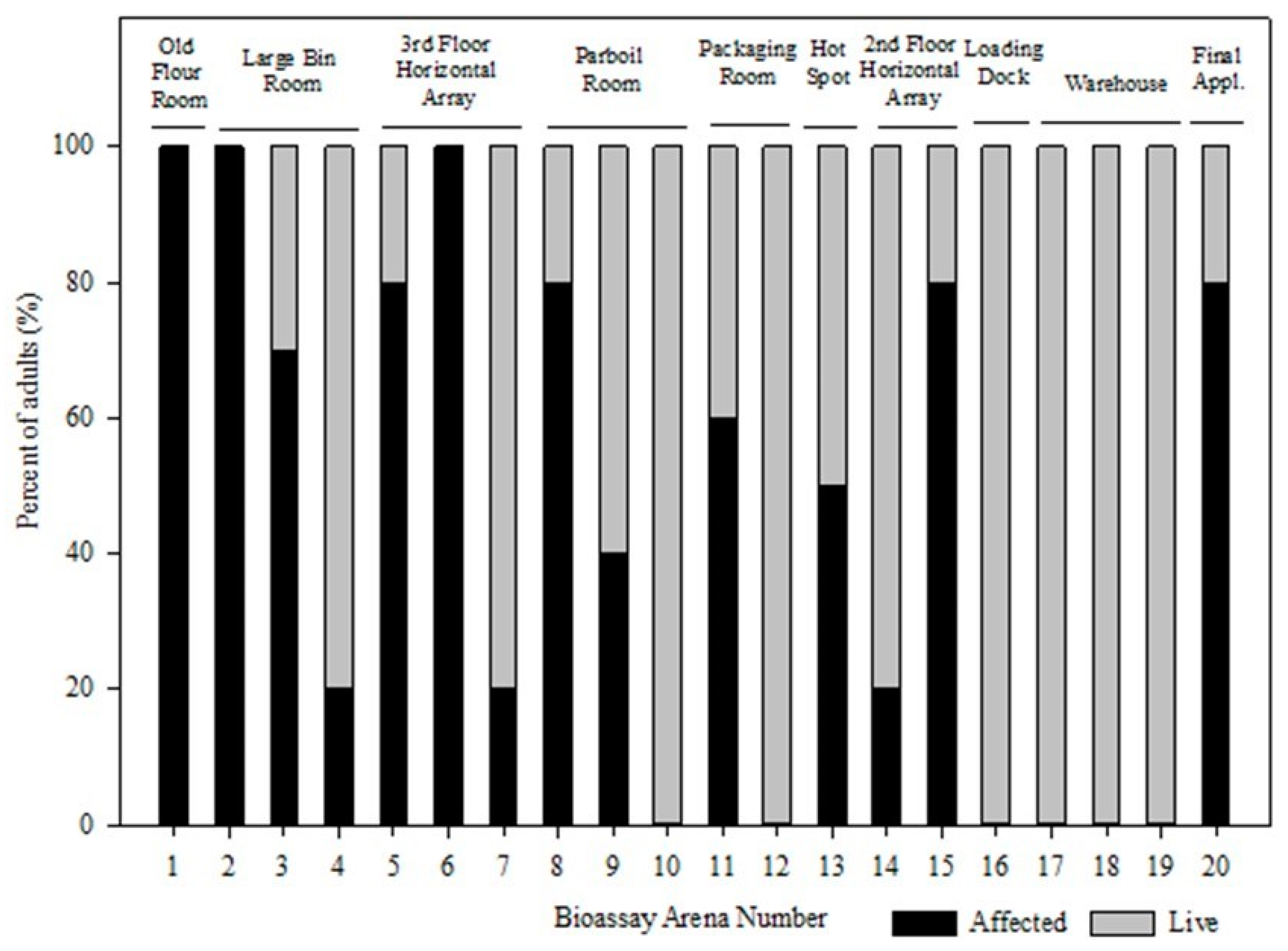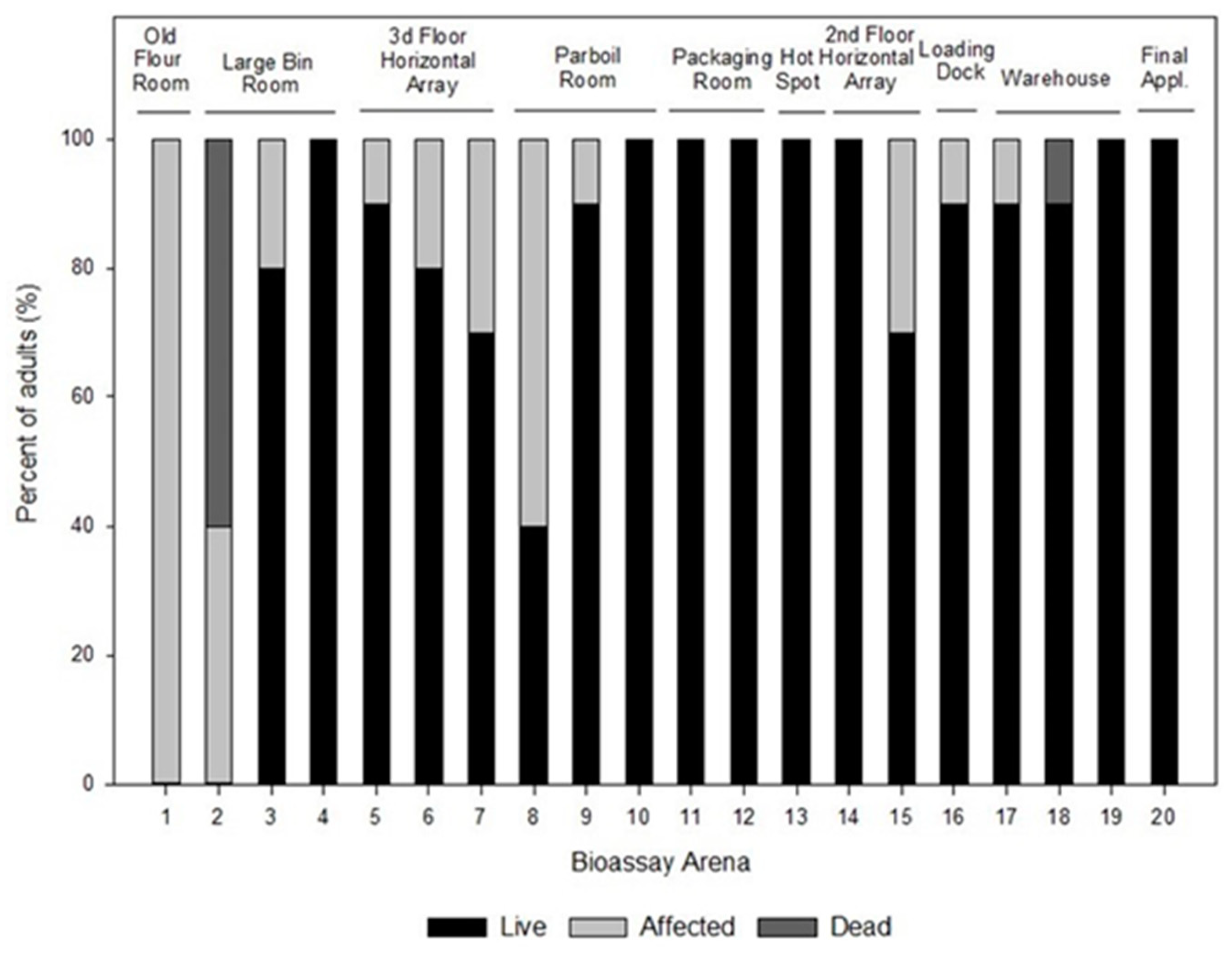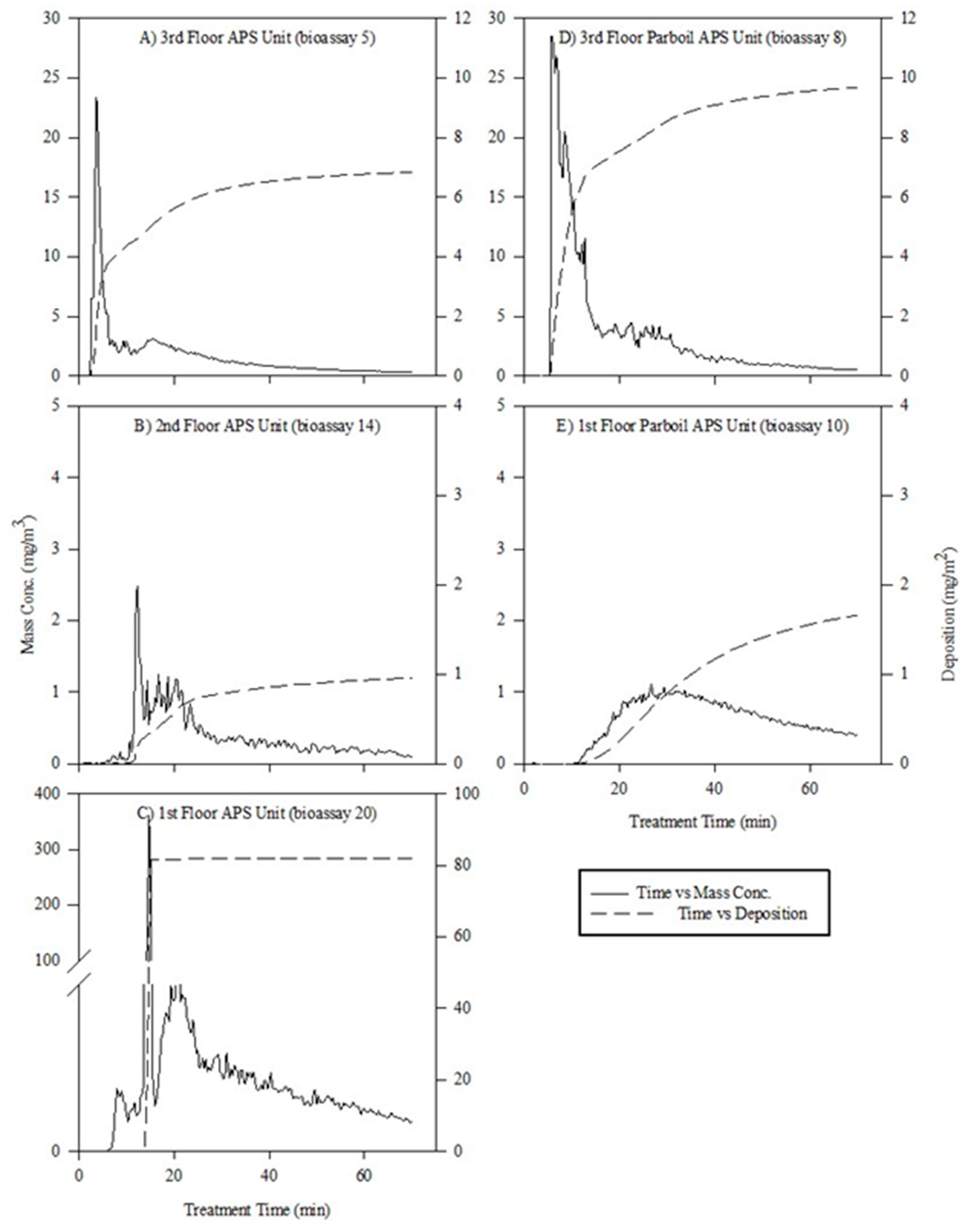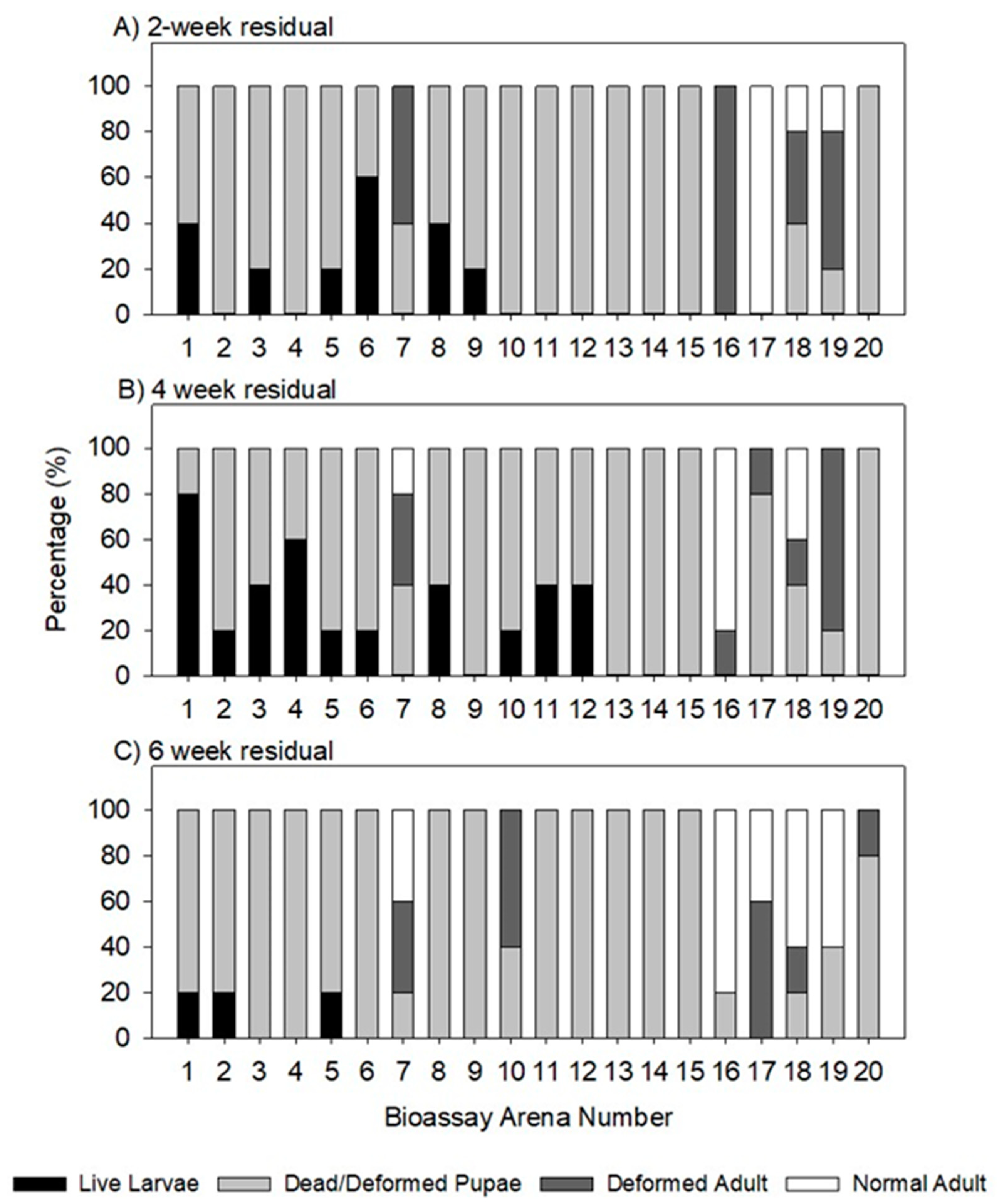2.1. Research Location
The aerosol application for this study took place in a commercial rice milling facility during the summer of 2016. The ambient temperature outside on the day of testing was approximately 29–33 °C. The specific name, location, and specific details about the rice mill cannot be disclosed due to the confidentiality agreement required to conduct research on the property. Due to the complexity of the facility, it was estimated that the volume of space treated to be greater than 25,000 m3, and a generalized description of the rice milling facility is as follows.
The milling complex consisted of three interconnected buildings that were treated: the parboil facility, milling facility, and shipping/warehouse facility (
Figure 1). The first building on the east side of the complex was the parboil facility, which was three stories tall with half of the space containing several large and tall rice storage bins, while the other half had parboiling equipment located on the first flour. The parboil facility was considered an open concept layout, with only grated walkways, flooring, and stairs to allow access to the top of the storage bins and movement up and down and throughout the air space.
The second building of the complex was the main milling facility, containing three separate and distinct floors and rice processing equipment, storage bins, and product packaging equipment. The third floor was laid out in a rectangular shape. On the south side of the third floor was a completely enclosed room that contained the old rice flour milling equipment, while on the northwest side of the third floor there was a doorway to the tops of four large rice storage bins. The room was termed large bin room. This storage area contained four large bin storage units. There was only one entry point, through a doorway, and the rest of the bin room was closed off from the third floor. There was a small walkway access to the top of the bins, but the remainder of the space was fully open to the first floor below, which was over 20 m below. The remainder of the third floor contained conveyers, structural beams, milling equipment, and the facility control room.
The second floor of the milling facility contained rows of rice milling equipment. On the west side of the second floor there was the finished rice packaging room. This area contained the filling and bagging equipment, conveyers, and other packaging equipment used to create a finished product that would be ready to ship. The bagging room was separated from the second floor by large, vertical plastic curtains. The first floor of the milling facility contained additional conveyer systems, structural beams, milling equipment, and machinery. On the northwest side was an access doorway to the bottom of the large bin storage, described previously. On the southwest side was access doorway to the shipping and receiving warehouse, which was separated by vertical plastic curtains.
The third building was the shipping and receiving warehouse. The warehouse was three-four stories high, with rows of storage racks that held large wooden pallets of finished products. The warehouse also contained two loading docks, on the first floor, where products could be loaded or unloaded from semi-trailers. The milling complex also had one building with administrative offices located next to the parboil facility. This building was separate from the milling complex and was not treated.
2.2. Bioassays and Particle Size Measurements
The T. confusum used in the study were from a pesticide-susceptible strain that has been maintained at the United States Department of Agriculture–Agricultural Research Service–Center for Grain and Animal Health Research (USDA-ARS-CGAHR) in Manhattan, KS, USA, for over 30 years. The T. confusum colony was reared on a diet of 95% whole wheat flour plus 5% brewer’s yeast and maintained in an environmental chamber at 27 °C and 60% r.h. in complete darkness.
Bioassay arenas were prepared as described in previous research [
7]. Briefly, a driveway patching material (Rockite, Hartline Products Co., Inc., Cleveland, OH, USA) was mixed with water to create a slurry. The slurry was poured in to the bottom 0.5 cm of a 60 × 15 mm plastic Petri dish (~ 22cm
2) to create concrete bioassay arenas. The arenas were allowed to dry at ambient conditions for a minimum of 48 h before use. Four individual treatment arenas were placed inside a larger 150 × 25 mm plastic Petri dish (~170 cm
2) as described in
Figure 2, to create one larger bioassay arena, and the group of arenas were placed at one of 20 locations throughout the rice-milling complex. An additional 10 bioassay arenas were prepared in the same manner and were used as untreated controls. Five bioassay arenas were placed in the office building, which is adjacent but separated from the parboil facility. Five additional bioassay arenas were placed in the milling control room located on the second floor of the milling facility. This area was closed off during application and no aerosol was applied due to computerized equipment. During aerosol applications, both entry/exit doors were shut to prevent aerosol particles from entering the room.
At each location, one of the four individual arenas (
Figure 2A) was used to determine the initial effect of the aerosol on adult
T. confusum; the three remaining arenas were used to determine the residual effect of the aerosol on 4-week old
T. confusum larvae at two, four, and six weeks post aerosol treatment. Prior to the aerosol treatment, 0.40 ± 0.01 g of
T. confusum diet was added to the testing arena along with 10 mixed-sex, 1–2-week-old adult
T. confusum. The three remaining concrete arenas did not contain diet. Following the aerosol application, the number of adult beetles that were affected in each arena was recorded and converted to a percentage (out of 10). Affected adult beetles were defined as on their backs, being unable to right themselves, or having impaired or no movement when observed.
After the aerosol application, the bioassay dishes were placed in large plastic tubs and transported back to the USDA-ARS-CGAHR facilities in Manhattan, Kansas, USA, where they were held in an environmental chamber set at 27 °C and 60% r.h. in complete darkness. Bioassay dishes containing adults were observed after 7 d post aerosol treatment, and the beetles were classified as live, affected, or dead, and converted to a percentage (out of 10).
The remaining concrete dishes exposed during the aerosol applications (
Figure 2B–D) were used to conduct two, four, and six-week residual testing, respectively, of the aerosol insecticide against 4-week old
T. confusum larvae. At these times, ten 4-week old larvae were placed on a concrete arena along with 0.40 ± 0.01 g of diet and monitored for adult emergence at 27 °C and 60% r.h. for up to 4 weeks. After 4 weeks, bioassay dishes were examined, and life stages were categorized as larvae, pupae (dead and/or deformed), deformed adults (twisted wings, split wings, missing elytra, etc.), or normal adults.
The aerosol was also evaluated by measuring the distribution of different aerosol particles (droplets) distributed to five different locations, using Aerodynamic Particle Sizer (APS) spectrometers (TSI Incorporated, Shoreview, MN, USA). Each APS location also had a corresponding bioassay arena. Each APS unit samples the air and counts the number of particles of different sizes over 20 second intervals. Data reported is the counts over an 80-minute period, ~240 sampling events, since after this period only small particles that did not settle remained in the air and there were no significant changes in particle sizes recorded. The count data were converted to mass concentration (mg/m3) per 20-second interval. Deposition was estimated from the combination of mass concentration and estimated settling of aerosol particles for each 20 second event. The total deposition per instrument location was the summation over the 80-minute sampling period.
2.3. Aerosol Treatment Positions and Bioassay Arena Locations
The aerosol insecticide was applied from different release points, as described below, throughout the entire milling complex, which includes the parboil room, three separate milling floors, packaging room, large bin room, and the shipping and receiving warehouse. The aerosol used in the study was a cylinderized pyrethrin (0.7%), piperonyl butoxide (5.0%), pyriproxyfen (0.267%), and other ingredients (94.033%), with a carbon dioxide (CO2) carrier (TurboCide Py-75 with IGR, ChemTech Ltd., Des Moines, IA, USA).
The aerosol application was done by a certified pesticide application. All doors and windows were closed and sealed, and the air ventilation system was shut off, in accordance to company policy. The aerosol application started at 08:00 hours, and the final aerosol release was at ~09:00 hours. The treatment holding period was approximately 2 hours, followed by a ventilation period to aerate the facility and remove any remaining aerosol particles. After the pesticide applicator deemed the facility to be safe, approximately 2 hours after final aerosol release, all bioassay dishes were collected. The entire aerosol application time from the start of application until all bioassay dishes were collected was 5 hours.
The cylinder containing the aerosol used for this field study was placed on a wheeled cart and released at 10 different locations throughout the complex, starting at the third-floor locations and moving downward to the first floor. The application location descriptions, along with bioassay locations, are described as follows.
Aerosol application location 1 was on the third floor in the old flour room and had the corresponding bioassay arena 1. Application location 2 was in the large bin room, with bioassay arenas 2, 3, and 4. Bioassay arena 2 was on the top of a bin on the third floor, while arena 3 was directly below arena 2 on the first floor and arena 4 was on the first floor but inside the bottom portion of one of the storage bins. These locations were used to determine if the aerosol was able to disperse downward to the first floor, when only released from the third floor. It was also used to tested if the aerosol was able to travel underneath/around the bin structures themselves.
Application location 3 was on the third floor of the milling building. The applicator released the aerosol in the middle of the floor and directed the spray to the east and west. Bioassay arenas 5, 6, and 7 were located on this floor. Arena 5 was located in the middle of the third floor along with APS unit #1, and along the route of the spray application. Arena 6 was located to the east of the aerosol release position, and arena 7 was on the western side of the floor between two beam structures. Arenas 5, 6, and 7 were all roughly in a linear line with each other, with arena 7 approximately twice the distance from the aerosol release position compared to arena 6.
Application location 4 was in the parboil room on the third floor, where bioassay arenas 8, 9, and 10 were located. Arena 8 was located on the top of the large bins, at roughly a 45° angle from the aerosol release point along with APS unit #2. Arenas 9 and 10 were located on the first floor of the parboil room. Arena 8 was located directly in front of where the aerosol was released from. This arena was designed to determine how effectively the aerosol dispersed downward through the metal grating. Arena 10 was also located on the first floor of the parboil room, underneath beam structures, along with APS unit #3.
Application location 5 was in the packaging room, along with bioassay arenas 11 and 12. Arena 11 was located in the middle of the floor, in a completely open position. Arena 12 was at a 90° angle from arena 11 and located underneath the conveyor system used for the packaging process. Application location 6 was on the 2nd floor in an arena deemed a "hot spot" by the milling manager. This location contained a large duct that went to the outside, and insects were previously spotted on the outside structure at this location. Bioassay arena 13 was placed directly underneath the duct work. Application location 7 was on the second floor and was associated with bioassay arenas 14 and 15. Both bioassay arenas were placed in-between the two rows of milling equipment. Arena 14 was on the western side of the floor, along with APS unit #4. Arena 15 was on the eastern side of the floor.
Application location 8 was in the warehouse building, specifically near the loading docks, and bioassay arena 16 was located in front of the loading docks. Application location 9 was also in the warehouse building, specifically in the section that held the rows of pallet racking. Bioassay arenas 17, 18, and 19 were located in this section. All bioassay arenas were placed in a straight line. Arena 17 was place in the middle of the floor. Arena 18 was placed on the outside edge of the racking system. Arena 19 was placed in the middle of the pallet racking system. Application 10 occurred on the first floor and was the final aerosol release position for the building. Arena 20 was located in an open position in the middle of the floor space, along with APS unit #5.
Exact distances between aerosol release positions and bioassay dishes could not be determined, because only the certified application could be in the building at the time of application. The certified applicator gave approximate positions of where they would release the aerosol, but the positions could vary. In addition, exact amounts of aerosol released at each position could not be determined. The cylinderized aerosol was equipped with a valve that registered open or closed and did not contain any mechanical or electrical readouts. The amount of aerosol used in the test was determined from label rates and the total volume of the three building facility. The certified applicator would stop at each pre-determined position and release some insecticide and then move on towards the next location.
Only one aerosol treatment was measured in the facility, due to constraints in scheduling and distance, so this analysis should be considered a case study of an aerosol application conducted on a large commercial scale. The multiple sampling locations will enable us to evaluate the variability aerosol particles among different locations in a facility, but this analysis needs to be viewed in conjunction with laboratory, small scale, controlled experiments from previous research [
3,
5,
7,
8,
9,
10].

